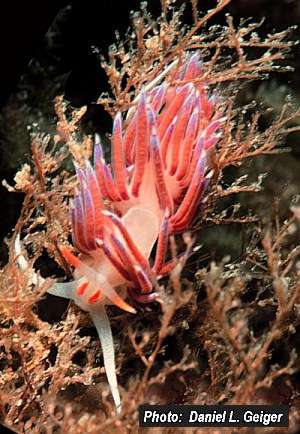
Cratena peregrina
(Gmelin, 1791)
Order: NUDIBRANCHIA
Suborder: AEOLIDINA
Family: Glaucidae
DISTRIBUTION
Mediterranean. Atlantic coast of Spain, Portugal, Senegal, Canary Ids.
PHOTO
Bandol: Ile de Bendor, Mediterranean coast, France, 1990, on hydroid colony Eudendrium sp..
PHOTO: Daniel L. Geiger.
Hervia costai Haefelfinger, 1961 is a synonym. Grows to 50mm long and feeds on hydroids of the genus Eudendrium.
Authorship detailsRudman, W.B., 1999 (June 5) Cratena peregrina (Gmelin, 1791). [In] Sea Slug Forum. Australian Museum, Sydney. Available from http://www.seaslugforum.net/find/cratpere
Related messages
Re: Cratena peregrina from India
November 3, 2009
From: Vishal Bhave

Dear Bill
The day before finding the Elysia [see message #22738] I found this Cratena peregrina - like species on a hydroid
Locality: Bhandarpule, Maharashtra, India. October 2009
Vishal Bhave.
vishalbhave@gmail.com
Bhave, V., 2009 (Nov 3) Re: Cratena peregrina from India. [Message in] Sea Slug Forum. Australian Museum, Sydney. Available from http://www.seaslugforum.net/find/22754
Dear Vishal,
If I had just seen this photo I would have put it aside as a 'mystery' but a recent post from Deepak Apte [message #22690] with a group of animals from Mumbai, which I am pretty sure are the Mediterranean Cratena peregrina, suggests that your animal is the same species.
In typically coloured animals, there are two large orange bands on the head, one between each rhinophore and oral tentacle. We can only see the left band in your animal and its seems to have a side branch. - perhaps this is just a peculiarity of this specimen. In all other features it matches Deepak's animals so I tentatively suggest it is also C. peregrina.
Best wishes,
Bill Rudman
The Mediterranean Cratena peregrina from Mumbai, India
November 3, 2009
From: Apte Deepak


Concerning message #9928:
One of our volunteers found this species in Mumbai on a rocky shore dominated by silt.
Locality: Mumbai, exposed rock pool, Maharashtra, Arabian Sea, 2 october 2009, Rocky shore dominated by mud. Length: 15 mm. Photographer: Deepak Apte.
Deepak Apte
spiderconch@gmail.com
Apte, D.A., 2009 (Nov 3) The Mediterranean Cratena peregrina from Mumbai, India. [Message in] Sea Slug Forum. Australian Museum, Sydney. Available from http://www.seaslugforum.net/find/22690
Dear Deepak,
This species certainly has similarities to Sakuraeolis nungunoides in the message you refer to [#9928] but the arrangement of the orange markings on the head and rhinophores is different and so is the arrangement of the cerata. In your animal the first group of cerata on each side is arranged in an upside down V shape while in all the other groups the cerata are in a single sloping line. In S. nungunoides all but the most posterior cerata are arranged in inverted Vs or arches.
By chance I have also received a post from Vishal Bhave [message #22754 ]with a photo of what appears to be the same species, also from the same part of India in which he likens his animal to the Mediterranean Cratena peregrina. Without an anatomical examination, I couldn't be 100% sure but on external shape and colour I have little doubt that your animals are C. peregrina. To my knowledge, these are the first records of the species in the Indo-West Pacific. If you look at the lessepsian migration page you will see that there is a growing incursion of Indian Ocean species into the Mediterranean. I suspect if this is C. peregrina - a Mediterranean species moving into the Indian ocean - then it the result of shipping or some other human activity.
A very interesting find
Best wishes,
Bill Rudman
Colour of cerata in Cratena peregrina
August 14, 2008
From: Dani Barchana
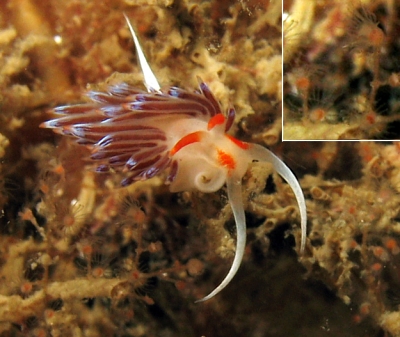
Concerning message #21056:
I think this is another example of how the colour of the ingested materials in the digestive glands is visible through the skin of the cerata.
Locality: Caesaria, 20-24 meters, Israel, Mediterranean, 10/07/2008, deep reef. Length: 3 cm. Photographer: Dr. Dani Barchana.
Dr. Dani Barchana
dani.barchana@gmail.com
Barchana, D., 2008 (Aug 14) Colour of cerata in Cratena peregrina. [Message in] Sea Slug Forum. Australian Museum, Sydney. Available from http://www.seaslugforum.net/find/21782
Thanks Dani,
Cratena peregrina shows quite a range of variation in ceratal colour so it would be interesting to know what it is feeding on when it has its very dark colour form [message #21220].
Best wishes,
Bill Rudman
Re: Cratena peregrina and Flabellina affinis together
June 6, 2008
From: Fabio Russo
Concerning message #20911:
Dear Bill, you are right, both those aeolid are feeding on hydroids of the genus Eudendrium! It is not rare to see those two species together on the same Eudendrium.
Best wishes,
Fabio Russo
frusso@mondomarino.net
Fabio, 2008 (Jun 6) Re: Cratena peregrina and Flabellina affinis together. [Message in] Sea Slug Forum. Australian Museum, Sydney. Available from http://www.seaslugforum.net/find/21612Thanks Fabio,
Best wishes,
Bill Rudman
Cratena peregrina and Flabellina affinis together
April 21, 2008
From: Luigi Montevecchi

Hi, Bill
This shot was taken in the Mediterranean sea at Corsica Island. The nudibranch on the right looks like a Cratena peregrina. On the left side I believe the aeolid is Flabellina affinis with her eggs. [I have labeled a copy of my photo for clarity] If it's so, what's the Cratena doing? Is she feeding on the same plant? I've never seen two different species so close each other.
Locality: Corsica Island, Site of dive: Lavezzi - Eceuil; depth: 10.7 meters, rocky bottom. France, Mediterranean Sea, 29 August 2007, Rocky bottom, Natural park. Length: 1 cm about. Photographer: Luigi Montevecchi.
I strongly appreciate any comment
Thanks in advance
Luigi
montevecchi@iol.it
Montevecchi L., 2008 (Apr 21) Cratena peregrina and Flabellina affinis together. [Message in] Sea Slug Forum. Australian Museum, Sydney. Available from http://www.seaslugforum.net/find/20911
Dear Luigi,
Firstly you are calling these animals 'she'. I know one is laying eggs, but all sea slugs are hermaphrodite with a full set of male and female organs so we can't really use 'he' or 'she' without offending their other half. Your identifications are correct, but the bushy plant-like growth they are both on is not a plant but a hydroid, which is a colonial animal related to sea anemones. Most aeolids feed on hydroids and most seem to eat only one or a few species - but we still have a lot to learn about their diets. I suspect in this case that both aeolid feeds on the same hydroid. It is a bit unusual to find more than one species of aeolid on a particular hydroid colony but when you do, it can be quite a spectacular sight.
Best wishes,
Bill Rudman
Colour variation of Cratena peregrina
March 6, 2008
From: Zeineb Alhaidari

Dear Bill,
I saw this very dark colour variant of Cratena peregrina in the etang de Thau , which is a pond of salty water with communications to the Mediterranean sea , and thought it could be of some interest for the forum.
Locality: Thau Pier, 7 metres, France, Mediterranean sea, 10 November 2007, Sediment. Length: 2 cm. Photographer: Zeineb Alhaidari.
Best regards , and thank you again for all the work,
Zeineb
z.alhaidari@wanadoo.fr
Alhaidari , Z., 2008 (Mar 6) Colour variation of Cratena peregrina. [Message in] Sea Slug Forum. Australian Museum, Sydney. Available from http://www.seaslugforum.net/find/21220Dear Zeineb,
Thanks for this record of a very dark specimen. I have seen very few photos of such a black specimen. Presumably it has been feeding on a similar coloured hydroid
Best wishes,
Bill Rudman
Cratena peregrina at lunch time
January 17, 2007
From: Dominique Horst

Dear Bill,
Back from my morning dive, I've realized on my PC screen, that I was lucky today to get a complete sequence of the lunch of a Cratena peregrina.
So I'm happy to share this on the forum. Having to select just 3 pictures was very hard.
Locality: Cap d'Antibes, 20m, France, Mediterranean sea, 07 January 2007, rocks. Length: 25mm. Photographer: Dominique Horst.
Kind regards,
Dominique
dominique.horst@wanadoo.fr



Dear Dominique,
This Cratena must have been down to the last polyp when you found it. I think you have made an excellent choice of photos. Since the skin of these animals is quite transparent you can often see internal structures. In this case I have put a ring around a curved tube which is the intestine, running from the stomach to the anus, which is obscured just behind one of the small cerata. Part of the duct is filled with an orange substance, which is the remains of the hydroids Cratena has been feeding on.
Best wishes,
Bill Rudman
Cratena peregrina and reproductive organs
December 1, 2006
From: Dominique Horst

Hi Bill,
Hope you spent nice holidays in Europe.
On the following pictures of Cratena peregrina, a kind of hole is visible on their right side after the second rank of cerata. Following your explanation about a similar structure on Hypselodoris tricolor (message #17001) , I've deduced that this correspond to reproductive ducts.
Do you agree on this ?
Locality: Cap d'Antibes, 8 m, France, Mediterranean sea, 24 August 2006, rocks on sand. Length: 20 mm. Photographer: Dominique Horst.
Many thanks for your continuous help on this forum.
Kind regards,
Dominique
dominique.horst@wanadoo.fr
Horst, D., 2006 (Dec 1) Cratena peregrina and reproductive organs. [Message in] Sea Slug Forum. Australian Museum, Sydney. Available from http://www.seaslugforum.net/find/18453
Dear Dominique,
Yes this is the genital opening. If you look just in front of the next row of cerata you will see a small grey spot (near a reddish mark). This is the kidney opening. The anus is further back amongst the next groups of cerata. This may seem a strange place to have all these body openings, but it is a historical record of how they have evolved from snails. Most higher animals [worms, crustacea, vertebrates etc] usually have a head end with a mouth and a tail end where the other openings are situated. But if you think of a snail, its shell has only one opening, so all its internal organs have to open together at the head end. How all the openings got there is still debated by malacologists, but during the evolution of sea slugs, the shell was discarded and the animal was free again to become bilaterally symmetrical, with a head at one end and a 'tail' at the other. In the process, some of the these openings began migrating down the right side of the body towards the 'tail'. In aeolids, they haven't got far, with the genital opening, anus and kidney opening still on the right side of the body near the front. In the dorids however, the anus and the kidney opening have moved to the back of the body, with the gills, and only the reproductive opening has stayed up the front on the right side.
Just as our coccyx bone lets us know our ancestors had tails, the position of a slugs reproductive opening lets us know they evolved from snails.
Best wishes,
Bill Rudman
Cratena peregrina having a ride on a fish
November 23, 2006
From: Dominique Horst


Hi Bill,
These photos are only for fun. After a long dive, with nothing exceptional, my friend showed me this show - Cratena peregrina - having a ride on the rock fish Scorpaena notata (Rafinesque, 1810). So in the end, we were lucky.
Locality: Cap d'Antibes, 5 m, France, Mediterranean sea, 1 September 2006, rocks. Length: 20 mm. Photographer: Dominique Horst.
Kind regards,
Dominique
dominique.horst@wanadoo.fr
Horst, D., 2006 (Nov 23) Cratena peregrina having a ride on a fish. [Message in] Sea Slug Forum. Australian Museum, Sydney. Available from http://www.seaslugforum.net/find/18454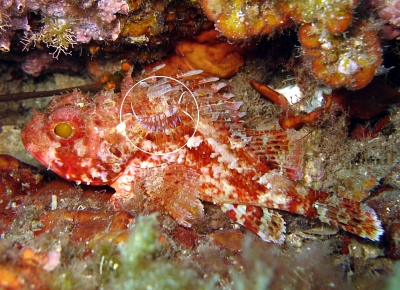
Dear Dominique,
Thanks for these nice photos. If I had realised just how many photos we were going to get on the Forum of nudibranchs crawling over scorpaenids and other fish with similar sedentary habits I would have started a 'visiting fish' page. I guess what all these fish have in common is that they spend a lot of time sitting very still waiting to ambush their prey. I guess part of sitting very still behaviour is putting up with small things creeping and crawling over you.
I must admit it does look quite incongruous to see such fragile animals venturing so close to quite dangerous predators.
Best wishes,
Bill Rudman
Cratena peregrina mating or fighting ?
August 24, 2006
From: Dominique Horst

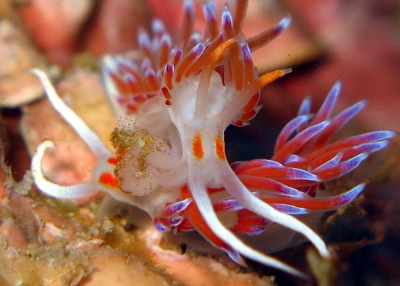
Hello Bill,
We still have many Cratena peregrina laying at this time. And last dive we observed a strange behaviour between two. I've make a choice between many photos I could take during this long scene. I've tried to take short clip, but I failed. During 6 or 7 minutes we observed two C. peregrina (small size) quit jumping on together, like a fighting. When I had a look to the photo taken, I saw a kind of green-brown powder around one of them. Could this was a scene of matting more than fighting ?
Locality: Cap d'Antibes, 15m, France, Mediterranean sea, 08 August 2006, vertical rock. Length: 10mm. Photographer: Dominique Horst.
I was very surprised of their animation, as usually slug are not moving very fast...?
Thanks in advance for your help and opinion.
Kind regards,
Dominique
dominique.horst@wanadoo.fr
Horst, D., 2006 (Aug 24) Cratena peregrina mating or fighting ?. [Message in] Sea Slug Forum. Australian Museum, Sydney. Available from http://www.seaslugforum.net/find/17516
Dear Dominique,
Glaucid aeolids are well known for being a bit aggressive so I guess you are right - they are doing a bit of mating and fighting. I suspect the 'green-brown powder' you mentioned is faecal matter. Nudibranchs will often empty their intestines when disturbed - and the anus is quite close to the reproductive openings. In the photo alongside, I have ringed what looks like brownish faecal matter, and two white sausage-shaped structures. I wouldn't be surprised if they are the egg masses of a parasitic copepod living on the back of the lower aeolid [as in your earlier message #17130 ].
Best wishes,
Bill Rudman
Cratena peregrina from Antibes, France
July 22, 2006
From: Dominique Horst

Dear Bill,
I've notice a strange twist on the left border of this Cratena peregrina. I thought initially that it could be the animal laying eggs, but I don't feel confortable with this. Apparently this kind of twist is made from the same material as the mantle and doesn't look like eggs. Could this be related to a reproductive organ ?
Locality: Cap d'Antibes, 6m, France, Mediterranean sea, 11 July 2006. Length: 30mm. Photographer: Dominique Horst.
The general context on the site these last days is an explosion of numerous Cratena peregrina, mating, laying eggs and the appearance of juveniles on hydroids. Also Flabellina affinis is associated with many individuals.
Many thanks for your help,
Kind regards,
Dominique
dominique.horst@wanadoo.fr



Dear Dominique,
Your reports from the French Mediterranean are always very welcome, especially now it is midwinter here in Sydney. Thanks for sharing these beautiful photos.
The strange twisted ribbon you mention are eggs, but they are not the eggs of the nudibranch. They are the paired egg sacs of a crustacean copepod parasite. Its body is embedded in the animal and only its egg sacs extrude out. It is surprisng how many records we now have on the Forum of nudibranchs, often aeolids, with these parasites.
Best wishes,
Bill Rudman
Re: Unidentified aeolid from Levant Sea
July 18, 2006
From: Baki Yokes
Concerning message #17116:
Dear Bill,
Many different colour varities of Cratena peregrina are found on Turkish coastline. I personally examined many of them. Colour of the cerata can be very different, but the milk white body colour and the two orange marks on the head are always present. I'm sure this is also an unusual coloured form of C. peregrina.
Best wishes
Baki
bakiyokes@turk.net
Yokes, M.B., 2006 (Jul 18) Re: Unidentified aeolid from Levant Sea. [Message in] Sea Slug Forum. Australian Museum, Sydney. Available from http://www.seaslugforum.net/find/17162Thanks Baki,
I dislike having to place animals in the 'unidentified' lists so your comment is very welcome.
Best wishes,
Bill Rudman
Unidentified aeolid from Levant Sea
July 12, 2006
From: Cem Çevik
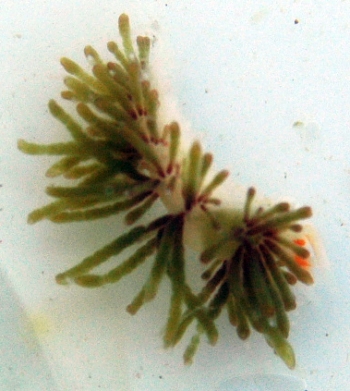
Dear Sir,
We have been studying mollusc biodiversity of Eastern Mediterranean (Levant Sea). During our last sampling we encountered this species in Iskenderun Bay, Turkey, North Eastern Mediterranean but could not identify it. If you can help us we will be happy.
Yours,
Asst.Prof.Dr. Cem Çevik
Çukurova University
Faculty of Fisheries
Department of Marine Biology
cem95@cu.edu.tr


Dear Cem,
It is unusual to find an aeolid with green digestive gland ducts in the cerata so this species should be easily identifiable if it has a name. Unfortunately I don't recognise it myself, but hopefully one of our participants from the Mediterranean region may be able to help. There also seem to be a purplish section at the base of each ceras and the tip seems to be a bit swollen and purplish as well. I can't make out whether the bright red-orange patches on the head are actually marks on the head, as in Cratena peregrina, or are colour bands on the rhinophores.
Let's hope someone will recognise it for you
Best wishes,
Bill Rudman
Cratena peregrina from Turkey
June 24, 2006
From: Kerem Turker

Dear Bill,
Here are some pictures of Cratena peregrina feeding on a hydroid colony.
Locality: Bodrum - Small Reef, 15 meters, Turkey, Mediterranean, 17 June 2006, Rocky - reef . Length: 25 mm. Photographer: Kerem Turker.
Regards,
Kerem
kerem.turker@pmintl.com
Turker, K., 2006 (Jun 24) Cratena peregrina from Turkey. [Message in] Sea Slug Forum. Australian Museum, Sydney. Available from http://www.seaslugforum.net/find/16918
Dear Kerem,
Thanks for these photos which show the colour pattern, including the orange patch on the side of the head, very well
Best wishes,
Bill Rudman
Cratena peregrina from Mediterranean Israel
September 23, 2005
From: Dan Firer

Hello Bill
I have another slugs to show you, any information will be welcomed.
It was taken 3 September 2005 on a wreck 26 metres deep, off shore from Naharyia, Israel, and was about 0.5 cm long. Photographer: Dan Firer
Best regards.
Dan Firer
danf@tx.technion.ac.il
Firer, D., 2005 (Sep 23) Cratena peregrina from Mediterranean Israel. [Message in] Sea Slug Forum. Australian Museum, Sydney. Available from http://www.seaslugforum.net/find/14809
Dear Dan,
This is a fairly common Mediterranean aeolid called Cratena peregrina. There are a number of species of Cratena around the world which have these bright orange marks on their 'cheeks' but I am pretty sure this is the only species from the Mediterranean with this colour pattern. The tangled white string in the background is its egg mass.
Best wishes,
Bill Rudman
Re: Caloria elegans? from the Messina Strait, Italy
March 17, 2005
From: Andrea Biddittu

Concerning my earlier message [#13089], Aurelio Giussani sent me another image of the same nudibranch [I have his permision to use it on the Forum]. In this photo it is possible to observe its head. It is clearly a specimen of Cratena peregrina.
Many thanks for your answers and attention.
Andrea Biddittu
andbid@libero.it
Biddittu, A., 2005 (Mar 17) Re: Caloria elegans? from the Messina Strait, Italy. [Message in] Sea Slug Forum. Australian Museum, Sydney. Available from http://www.seaslugforum.net/find/13347
Dear Andrea,
Thanks very much for getting back to me with this. It is very nice to be able to solve a puzzle. In the close-up alongside we can clealry see at least the red spot on the left side of the head. And congratulations to Andrej [#13133] who got it right.
Best wishes,
Bill Rudman
Re: Caloria elegans? from the Messina Strait, Italy
February 11, 2005
From: Andrej Jaklin
Dear Andrea and Bill,
I would say that animal on this photo is Cratena peregrina, rather than colour form of Caloria elegans.
Best wishes,
AJ
jaklin@cim.irb.hr
Jaklin, A., 2005 (Feb 11) Re: Caloria elegans? from the Messina Strait, Italy. [Message in] Sea Slug Forum. Australian Museum, Sydney. Available from http://www.seaslugforum.net/find/13133Thanks Andrej,
As Lucas Cervera as suggested in another message, it's sometimes impossible to be sure from a single photo. I agree it colour looks very like that of Cratena peregrina, but as we can't see the head properly, the characteristic red patches can't be seen. However the anterior cerata seem to be in a single arch rather than a number of rows, so Caloria elegans isn't very likely.
Best wishes,
Bill Rudman
Re: Caloria elegans? from the Messina Strait, Italy
February 11, 2005
From: Juan Lucas Cervera
Hi Bill,
I cannot confirm your ID, but I cannot give an alternative. Only with this photo, no.
Sorry.
Lucas.:
lucas.cervera@uca.es
Cervera, J.L., 2005 (Feb 11) Re: Caloria elegans? from the Messina Strait, Italy. [Message in] Sea Slug Forum. Australian Museum, Sydney. Available from http://www.seaslugforum.net/find/13138Thanks Lucas,
I agree, without being able to see the head - its colour and tentacles - make identification pretty impossible
Best wishes,
Bill Rudman
Caloria elegans? from the Messina Strait, Italy
February 10, 2005
From: Andrea Biddittu

Hi Bill,
I cannot identify this image by Aurelio Giussani and available at www.mondomarino.net. The image is from the Messina Strait, at 15 m depth. For some details, it seems a specimen of Facelina bostoniensis, but for many other details (too many details) seems another species. Can you help me in this identification? I have permission from the photographer to post the photo on the Forum
Locality: Messina Strait, Italy. Mediterranean Sea. Depth: 15 m. February 2000. rocky bottom. Photographer: Aurelio Giussani
Andrea Biddittu
andbid@libero.it
Biddittu, A., 2005 (Feb 10) Caloria elegans? from the Messina Strait, Italy. [Message in] Sea Slug Forum. Australian Museum, Sydney. Available from http://www.seaslugforum.net/find/13089Dear Andrea,
I am not an expert on the Mediterranean fauna but I suspect this is a colourful form of Caloria elegans. It looks quite like photos I have seen from Britain, while all the photos on the Forum from the Mediterranean are of black & white animals. Hopefully someone will confirm or correct my identification.
Best wishes,
Bill Rudman
Cratena peregrina from Croatia
October 11, 2003
From: Adam Petrusek

Dear Bill,
Here is a photo of Cratena peregrina and in the bottom of the dish is one I do not have a clue about...
Could you help?
Locality: Adriatic sea, near Sumartin, island Brac, Croatia.
first week of September 2002
Photographed in the petri dish during the Mediterranean Marine Fauna excursion of the Charles University, Prague. Photo: Adam Petrusek.
All the best
Adam
petrusek@cesnet.cz
Petrusek, A,, 2003 (Oct 11) Cratena peregrina from Croatia. [Message in] Sea Slug Forum. Australian Museum, Sydney. Available from http://www.seaslugforum.net/find/11190Thanks Adam,
Thanks for the photo of Cratena peregrina. Where possible I try and keep species separate in the Forum so I have copied your mystery animal to a separate message.
Best wishes
Bill Rudman
Cratena peregrina from Turkey
August 20, 2003
From: Ferda Buyukbaykal

Dear Bill,
Is this Cratena peregrina?
Date: August 08, 2003
Location: Canakkale, Saroz
Site: Tuneller
Depth: 3-5 mt
Size: 35-40 mm
Photos: Ferda Buyukbaykal
Best regards
Ferda
ferdabbaykal@isnet.net.tr
Buyukbaykal, F., 2003 (Aug 20) Cratena peregrina from Turkey. [Message in] Sea Slug Forum. Australian Museum, Sydney. Available from http://www.seaslugforum.net/find/10768Dear Ferda,
Although I can't see the orange marks on the head, I am sure your identification is correct.
Best wishes
Bill
Cratena peregrina & eggs from Mediterranean
July 23, 2003
From: Marina Poddubetskaia

Dear Bill,
As promised in my earlier message, I looked at Cratena peregrina eggs in Cerbere where this species is very common. I saw an animal laying eggs in the tank, so now I'm sure these white coiled egg-ribbons do belong to this species.
Date: July 12, 2003
Location: Cerbere, France, Mediterranean coast
Site: Les 3 moines
Depth: 6m
Egg-ribbon length: 15mm
Animal size: 25mm
Photos: Marina Poddubetskaia - Nembro website
Cordially,
Marina.
nembro@nembro.info
Poddubetskaia, M., 2003 (Jul 23) Cratena peregrina & eggs from Mediterranean. [Message in] Sea Slug Forum. Australian Museum, Sydney. Available from http://www.seaslugforum.net/find/10471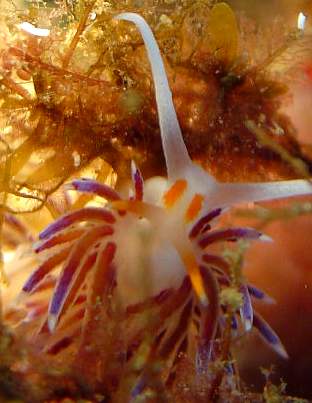
Thanks Marina,
Another little mystery solved
Best wishes,
Bill Rudman
Cratena peregrina from Senegal
July 16, 2003
From: Marina Poddubetskaia

Dear Bill,
I can confirm for you that Cratena peregrina is very common in Senegal: I saw this species in most sites.
I didn't see any Cratena peregrina laying eggs, but I found an hydroid with many Cratena on it and with several egg-ribbons like in second photo. Of course, we can't be 100% sure it belongs to this species, but I think it is likely to be. Next week I will go to Cerbere and try to see if Mediterranean Cratena have the same egg-ribbons.
Upper Photo:
Dakar, Senegal, Eastern Atlantic
Site: Iles Madeleine, Depth: 13m. May 27, 2003. Size: 15-20mm
Photos with egg ribbon:
Senegal, Eastern Atlantic. Site: Roches de Bargny., Depth: 11m. June 04, 2003. Animal size: 20-25mm
Photos: Marina Poddubetskaia - Nembro website
Cordially,
Marina.
nembro@nembro.info



Thanks Marina,
The egg mass looks very similar to the one in Erwin Koehler's photo. I have included a close-up of the head alongside to show some detail of the colour pattern.
Best wishes
Bill Rudman
Re: Cratena peregrina from Senegal
April 7, 2003
From: Juan Lucas Cervera
Dear Bill and Marina,
This species has been recorded in Canary Islands also.
Regards.
Lucas.
lucas.cervera@uca.es
Cervera, J.L., 2003 (Apr 7) Re: Cratena peregrina from Senegal. [Message in] Sea Slug Forum. Australian Museum, Sydney. Available from http://www.seaslugforum.net/find/9580Thanks Lucas,
Bill Rudman
Cratena peregrina from Senegal
April 4, 2003
From: Marina Poddubetskaia


Dear Bill,
Here is a record of Cratena peregrina from the Atlantic.
This photo was also taken by Patrice Petit de Voize [PdeVoize@aol.com] on the Tacoma wreck in Senegal in April 2001.
Best wishes,
Marina (and Patrice).
nembro@nembro.info
Poddubetskaia, M., 2003 (Apr 4) Cratena peregrina from Senegal. [Message in] Sea Slug Forum. Australian Museum, Sydney. Available from http://www.seaslugforum.net/find/9501Dear Marina and Patrice,
Thanks again. Garcia-Gomez records it from southern Portugal and Spain, but I know of no West African records.
Best wishes,
Bill Rudman
Facelina auriculata from Turkey
January 16, 2003
From: Ferda Buyukbaykal

Dear Bill,
Could you identify this photo?
Image Data: Tisan-Mersin, Turkey. June 2001, kurt burnu, 18 mt / 5-7mm, algae covered rocky.
Best wishes
Ferda
ferdabbaykal@isnet.net.tr
Buyukbaykal, F., 2003 (Jan 16) Facelina auriculata from Turkey. [Message in] Sea Slug Forum. Australian Museum, Sydney. Available from http://www.seaslugforum.net/find/8886This is Cratena peregrina. See Baki's message
Dear Ferda,
It's often difficult to identify aeolid nudibranchs unless you can get a good look at the head so you can see, not only the colour pattern, but the shapes of the rhinophores, cerata, and other body parts. In this case I am pretty sure this is one of the colour forms of Facelina auriculata, which in some books is still called Facelina coronata.
Best wishes,
Bill Rudman
Re: Facelina auriculata from Turkey
January 16, 2003
From: Baki Yokes
Dear Bill,
Ferda's photo reminds me the brownish colour form of Cratena peregrina, which is quite common in Turkish waters. In this form the cerata are brown in colour with fluorescent blue tips like the one in M. Poddubetskaia's message. The bright yellow tips of the long rhinophores are also look similar with that of C. peregrina.
Best wishes
Baki
bakiyokes@turk.net
Dear Baki,
I totally agree with your comments. As I said to Ferda, without a good look at an aeolid's head, identification can be difficult. Local knowledge makes all the difference. Without the characteristic red marks being visible, I doubt if I would have thought of C. peregrina.
Thanks,
Bill Rudman
Re: Facelina auriculata from Turkey
January 16, 2003
From: Erwin Köhler
Hi Bill,
Ferda's aeolid looks for me more like a variant of Cratena peregrina. I have often seen specimens with dark cerata like this.
Erwin
Erwin@medslugs.de
Thanks Erwin,
I agree,
Bill Rudman
Cratena peregrina from French Mediterranean
July 26, 2002
From: Marina Poddubetskaia


Dear Bill,
Here are some photos of Cratena peregrina. This eolid is easy to recognise because of its two orange-red patches on the head. The photos are from Cerbere, on the Mediterranean coast of France.
Upper: July 03, 2002, Site: Port-bou., Depth: 5m, Size: 3-4cm.
Lower: June 30, 2002, Site: Canadells., Depth: 16m, Size: 2-3cm.
Photos: Marina Poddubetskaia - Nembro website
Best wishes,
Marina.
nembro@nembro.info
Poddubetskaia, M., 2002 (Jul 26) Cratena peregrina from French Mediterranean. [Message in] Sea Slug Forum. Australian Museum, Sydney. Available from http://www.seaslugforum.net/find/7573Thanks Marina,
The combination of red marks on the head, and cerata with red digestive gland and blue tips certainly make this a very recognisable species.
Best wishes,
Bill Rudman
Cratena peregrina egg-laying
March 18, 2001
From: Erwin Koehler

Dear Bill,
here is a photo of 2 Cratena peregrina, one of them is spawning, laying eggs or however this is called in English ... I send this photo to compare the egg-mass with the one of Flabellina affinis which I am sending to you in another message.
Data:
size:about 4 cm,
depth: 9 m,
May 20, 1997, Spain, Cala Joncols, divesite: "Cabo Norfeo"
Erwin
Erwin@medslugs.de
Koehler, E., 2001 (Mar 18) Cratena peregrina egg-laying. [Message in] Sea Slug Forum. Australian Museum, Sydney. Available from http://www.seaslugforum.net/find/3939Thanks Erwin,
There's nothing wrong with your English - I wish my German was half as good!
Best wishes,
Bill Rudman
